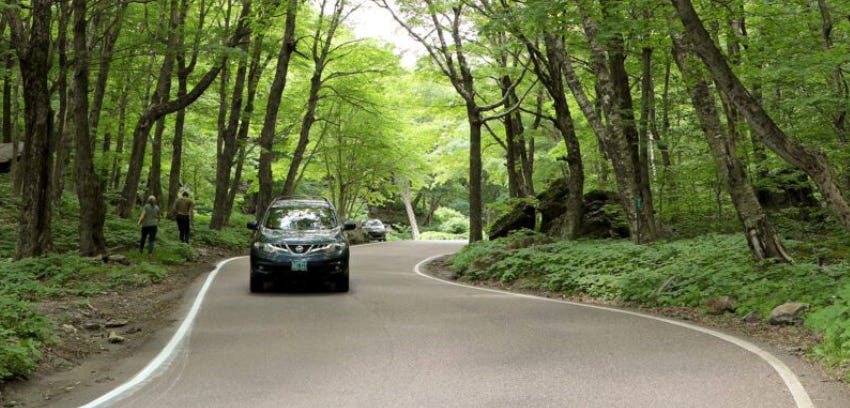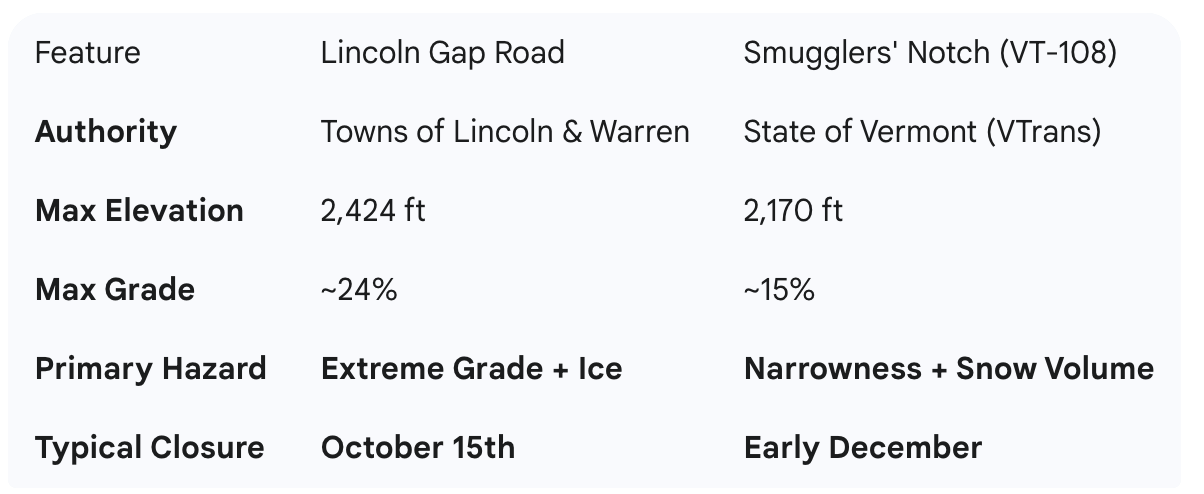The Steepest Paved Mile in the US: Why Lincoln Gap Closes on October 15th
Cresting at 2,424 feet, it’s the highest vehicle-accessible mountain pass in Vermont that creates its own microclimate, meaning ice and snow can appear weeks before they do at lower elevations.
Every year, like clockwork, physical barriers go up at the base of Lincoln Gap Road, closing it to vehicle traffic for the next seven months. For some, the October 15th closure can feel premature, often happening when the valleys are still awash in autumn color.
But this isn’t an arbitrary date. It’s a carefully calculated decision rooted in the road’s extreme nature, making it one of the most unique—and dangerous—stretches of pavement in the country. This article breaks down the complex factors that make the early closure a non-negotiable matter of public safety.
An Engineering Outlier
The core reasons for the closure are built directly into the mountain itself. Lincoln Gap Road isn’t just a road; it’s an engineering marvel pushed to its absolute limits.
Elevation and Weather: Cresting at 2,424 feet, it’s the highest vehicle-accessible mountain pass in Vermont. According to Wikipedia, this altitude creates its own microclimate. Temperatures at the summit drop sooner and more dramatically than in the towns of Lincoln and Warren below, meaning ice and snow can appear weeks before they do at lower elevations.
The Legendary Grade: The single most critical factor is its steepness. The eastern side from Warren is widely reported to be the steepest paved mile in the United States. According to cycling data sources, while the average grade for this section is a staggering 15%, certain pitches hit an almost unbelievable 24%. For comparison, most interstate highways are designed with a maximum grade of 6%. This extreme gradient is simply not built for winter conditions.
Primitive Design: Compounding the steepness is the road’s geometry. The Lincoln Gap Road Winter Access Study, conducted by the Addison County Regional Planning Commission (ACRPC), describes the road as “extremely narrow” with “very limited line-of-sight” and sharp, winding turns. There are no shoulders to speak of, leaving zero margin for error. The road follows a historic path, not a modern highway design, and its limitations are permanent.
The Impossible Task of Winter Maintenance
The road’s geography makes winter maintenance not just difficult, but impossible and life-threatening.
The ACRPC’s study is blunt, concluding that the road “cannot be plowed safely in its entirety.” A multi-ton snowplow attempting to navigate a 24% grade coated in ice would have an extremely high risk of losing traction and sliding, a potentially fatal scenario for the operator.
Even if plowing were possible, the risk to the public is too great. Each year, despite signage, drivers—often misled by GPS apps not updated with seasonal closures—attempt to cross the gap. They drive up from the clear valleys only to become stranded in deep snow and ice at the summit.
According to the Town of Warren and the ACRPC, a stranded car in Lincoln Gap is a life-or-death emergency. Emergency vehicles often can’t reach them, forcing rescue crews to proceed on foot in harsh conditions. For this reason, official policy is absolute: town trucks and commercial tow companies will not enter the closed section to sand, plow, or tow. Anyone who ignores the barriers is, as the town states, “totally at their own risk.”
The closure is also a crucial risk-management strategy for the small, rural towns of Lincoln and Warren. A single complex rescue on the gap could tie up the majority of their limited emergency personnel for hours, leaving the rest of the community dangerously exposed.
A Tale of Two Towns, Not the State
A key piece of the puzzle is jurisdiction. Lincoln Gap Road is a Town Highway, not a state-run route like Route 108 through Smugglers’ Notch. This means the Selectboards of Lincoln and Warren are responsible for its maintenance and closure.
This local control allows for a pragmatic, safety-first approach. The towns are directly accountable to their residents for both safety and fiscal responsibility. The cost of a major rescue operation or damage to a municipal plow truck would be a significant and avoidable burden on local taxpayers. Therefore, they can implement a zero-risk policy that is both safer and more financially sound.
The Tale of Two Notches: Lincoln Gap vs. Smugglers’ Notch
To understand why October 15th is the chosen date, a comparison to Vermont’s other famous seasonal pass, Smugglers’ Notch (VT-108), is essential.
Smugglers’ Notch typically closes much later, often in early December. The reason for this six-week difference lies in the primary hazard for each road.
As the comparison shows, the number one threat on Lincoln Gap is ice. The first hard freeze of autumn, which can easily happen in mid-October at 2,400 feet, can create a thin, invisible layer of black ice. On a 24% grade, this would make the road lethally slick. The October 15th date is set to proactively prevent this specific, catastrophic scenario.
Smugglers’ Notch, while also steep and narrow, closes later because its main threat is snow volume. The pass becomes impassable when enough snow accumulates to physically choke the narrow passages between its massive boulders, something that typically doesn’t happen until early winter.
Winter’s Silver Lining
While the closure ends the driving season, it marks the beginning of a new one. The unplowed road transforms into a beloved recreational asset.
According to the Green Mountain Club and the ACRPC, the closed gap becomes a haven for snowshoers, backcountry skiers, and cross-country skiers, providing safe, car-free access to the Long Trail and the high peaks.
Furthermore, the seven-month closure creates a quiet, undisturbed corridor for wildlife during the harshest time of the year. This period of tranquility, as noted in the ACRPC report, is a significant benefit to the ecological health of the Green Mountains.
In the end, the annual closure of Lincoln Gap is a logical and responsible decision. It is a successful adaptation to a uniquely challenging environment that prioritizes human life, protects emergency responders, and respects the fiscal limits of its local communities, all while creating a celebrated space for winter recreation and wildlife.




